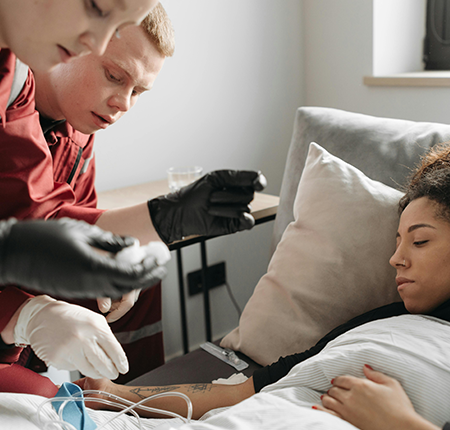
Have you been told that you have uterine fibroids during a routine gynecological check-up, or do you suspect that you have one? Uterine fibroids are the most common non-cancerous gynecological tumor and can occur at any age.
Don't worry, most fibroids don't lead to serious complications. For small fibroids that don't cause symptoms, no treatment is needed. But it's important to keep them under observation through regular visits to your gynecologist, so that treatment can be started early when necessary. Read the article and find out what causes fibroids, what the symptoms are, and what treatments are available.
What is uterine fibroid?
A uterine fibroid is a noncancerous growth that occurs in the uterus. It is a benign tumor made up of fibrous tissue and muscle and develops in or around the uterus, usually during the reproductive years. It is not cancer, and it almost never turns into a cancerous growth.
Also called myoma or leiomyoma , fibroids cause growths in the uterine wall, either in whole or in a specific portion. Their size can be so small that they are invisible to the naked eye, or they can grow to be larger than a grapefruit.
Most women don't even know they have uterine fibroids, and only find out during a routine gynecological examination, because they don't show symptoms. According to statistics, symptoms occur in only 1 in 3 women.
How common is uterine fibroids?
Uterine fibroids are the most common non-cancerous gynecological tumor. They affect approximately 40% of women between the ages of 35 and 50, but up to 80% of women have at least one fibroid during their lifetime.
Fibroids generally do not appear during puberty or before the first menstrual period, so girls who have not yet started their menstrual cycle are usually not affected. Fibroids also occur less frequently in women who have gone through menopause.

Types of uterine fibroids and their location
Uterine fibroids can grow as single formations or in groups. Their sizes start from 1 mm and can reach over 20 cm in diameter. These growths can be located in the uterine wall, in the main cavity or on the outer surface. Depending on all these factors, there are several types of uterine fibroids:
Submucous uterine fibroid
This type of fibroid grows under the inner lining of the uterus and develops in the uterine cavity. Because of its location, submucosal fibroids can lead to heavy menstrual bleeding, pelvic pain, and complications during pregnancy, including miscarriage or infertility.
Subserosal uterine fibroid
Subserosal fibroids develop under the lining of the outer surface of the uterus. They grow in the pelvis and can reach quite large sizes.
Intramural uterine fibroid
Intramural fibroids are the most common type of uterine fibroids. They grow in the muscular wall of the uterus and can cause heavy menstrual bleeding, pelvic and back pain, urinary and digestive disorders, or fertility problems.
Intraligamentous uterine fibroid
Intraligamentous, or cervical, uterine fibroids are very rare. They grow in the cervix and the ligaments that support the uterus.
Uterine fibroids - Causes and risk factors
The exact causes of uterine fibroids are unknown, but doctors believe that estrogen and progesterone may play a role. This may explain why fibroids usually appear in women of reproductive age, rather than in teenagers.
According to studies, high hormone levels (such as those during pregnancy) have been associated with the growth of fibroids, while low hormone levels have been correlated with their shrinkage.
Several risk factors have also been identified, which we explain below.
Hormonal factors
Due to the impact of estrogen and progesterone on the development of fibroids, women are more likely to be affected during their childbearing years. The predisposition may also increase depending on:
- Hormonal treatments
- Number of tasks
- Menopause
- Hormonal imbalances
Genetic factors
Women who have relatives with uterine fibroids on the maternal side are more likely to be affected.
The risk of developing fibroids is also higher in black women. By comparison, about 50% of black women have asymptomatic fibroids, while only 25% of white women are affected.
Body weight
Being overweight is another factor that can increase the risk of developing uterine fibroids.
Uterine fibroids - Common symptoms
In most cases, uterine fibroids do not cause any symptoms. Asymptomatic women may not even know they have these growths until they are detected during a routine gynecological checkup.
However, about 1 in 3 women with uterine fibroids also experience symptoms. The most common symptoms caused by these growths include:
- Heavy menstrual bleeding that requires frequent changes of pads and tampons , or unusual intermenstrual bleeding.
- Increased abdominal size, which creates the impression of pregnancy
- Pelvic pain or abdominal pressure
- Pain during sexual intercourse

Uterine fibroids - How is the diagnosis made?
Generally, the gynecologist detects these growths during a pelvic exam, during a routine consultation, or following suspicions created by symptoms such as heavy menstrual bleeding.
Once identified, several investigations can be performed to confirm the diagnosis of uterine fibroids and more accurately determine their size:
- Gynecological consultation and abdominal palpation: to determine the location and size of any formations.
- Sonohysterography with saline infusion: a small amount of saline is introduced into the uterus to highlight its contour and obtain clearer images than during an ultrasound.
- Transvaginal ultrasound: allows detailed observation of the number of fibroids and their size.
- MRI or hysteroscopy: MRI uses radio waves and magnetic fields to produce detailed images of internal organs, while hysteroscopy involves inserting a flexible tube with a camera at the end through the vagina and cervix into the uterus, allowing the doctor to examine uterine fibroids.
- Other investigations: as appropriate, other investigations may be performed before confirming the diagnosis, including ultrasonography, computed tomography, hysterosalpingography, or laparoscopy.
Treatment for uterine fibroids
When uterine fibroids are very small and not causing any problems, treatment may not be necessary. It is recommended to keep the patient under observation through regular gynecological check-ups, and an expectant approach based on the idea that the size of uterine fibroids decreases after menopause.
If the fibroids are not small, or produce different symptoms, treatment will be given depending on how many and large the formations are, where they are located, how severe the symptoms are, how old the patient is, and whether or not she wants to become pregnant.
Drug treatment for uterine fibroids
Depending on the symptoms, the doctor may recommend hormonal or nonhormonal drug treatment.
For abdominal pain and discomfort caused by fibroids, analgesics are recommended. In the case of anemia caused by heavy menstrual bleeding, iron supplements are recommended.
When fibroids cause more severe symptoms, such as heavy bleeding during and between periods or severe menstrual pain, hormonal treatments such as birth control pills may be recommended. These target the hormones that influence the menstrual cycle, namely estrogen and progesterone.
Gonadotropin-releasing hormone (GnRH) antagonists may be prescribed to shrink fibroids before surgery to make them easier to remove. This is a temporary treatment, not a permanent one, as fibroids tend to grow back after treatment is stopped.
Surgical treatment for fibroids
Surgical treatment is the main method of treating uterine fibroids, and is recommended when the size of the fibroids leads to constipation or other complications, when heavy and abnormal bleeding occurs, or when the patient cannot become pregnant or has repeated miscarriages.
Depending on the type of intervention on fibroids, the doctor may perform a:
- Hysterectomy: removal of the uterus, recommended for patients who do not intend to become pregnant, who are prone to other diseases, or who experience heavy bleeding and do not respond to other treatments.
- Myomectomy: removal of fibroids without removing the uterus, recommended for patients who plan to become pregnant or want to keep their uterus. The disadvantage of myomectomy is that it does not eliminate the risk of new fibroids developing in the future.
- Endometrial ablation: usually recommended along with myomectomy when fibroids cause heavy menstrual bleeding.
- Uterine artery embolization: recommended to relieve symptoms caused by fibroids, for women who do not intend to become pregnant, but wish to keep their uterus.
- Myolysis: consists of destroying the uterine fibroid through heat (thermal coagulation) or cold (cryoablation).
- MRI-guided ultrasonic focusing: allows the heating and destruction of fibroid tissue in the uterus using high-intensity ultrasonic waves, guided by magnetic resonance imaging (MRI).
Uterine fibroids - Associated complications
Uterine fibroids do not lead to serious complications in most cases. However, when they do occur, the most common complications are unbearable pain, swelling of the abdomen and pelvic area, excessive bleeding leading to anemia, and, extremely rarely, infertility.
Uterine fibroids and fertility
Uterine fibroids rarely cause fertility problems. Most women can get pregnant without any problems even with uterine fibroids.
Can a uterine fibroid affect fertility?
Whether or not fibroids affect your ability to get pregnant depends a lot on where the growths are located. If they are located in the uterine cavity, then yes, they can cause infertility. The same is true for older women who have multiple fibroids.
But when the formations appear outside the uterus, they are not associated with fertility problems as long as their size does not exceed 10-15 cm.
Risks in pregnancy
According to research, most women can become pregnant and carry the pregnancy to term without complications, even with uterine fibroids. However, there is a higher risk of miscarriage, stillbirth, or premature birth in women who have at least one uterine fibroid larger than 5-6 cm.
Treatment of fibroids before conception
Treatment of fibroids before conception depends on the location, size, and symptoms caused by these formations.
If it does not cause symptoms, treatment consists of surveillance and regular check-ups.
If it causes symptoms, then drug treatments and surgical interventions such as myomectomy, which does not involve removing the uterus, may be recommended.
Pregnancy after myomectomy: what you need to know
Pregnancy is possible after myectomy, but patients are advised to wait until they are completely healed following the procedure.
There is no standard optimal time frame, but it takes an average of 3 months for the uterine wall to fully heal. It is universally accepted that pregnancy should be avoided during this period. Healing time varies for each patient, but can be as long as 6-12 months depending on how the surgery went.
Sometimes, the doctor may recommend cesarean delivery for pregnancies achieved after a myomectomy.

Uterine fibroids - Can they be prevented?
There is currently no scientific evidence to prevent uterine fibroids. In general, they cannot be prevented, but the risk of their occurrence can be reduced by:
- Maintaining a healthy body weight
- Adopting a healthy lifestyle
- Stress management
Regular gynecological check-ups are essential to detect fibroids early. For small formations, establish a plan with your doctor to keep them under observation.
Frequently asked questions about uterine fibroids
Are you still worried or have questions after reading all the information about uterine fibroids? You're not alone. Below, we've gathered the most frequently asked questions about how they appear, how quickly they grow, and how they can progress, along with simple and clear answers that will help you understand everything better and feel more informed.
Can a fibroid shrink without treatment?
Yes, sometimes fibroids can shrink on their own, especially after menopause when hormone levels naturally drop. But this process can take years, and some fibroids can grow without treatment and cause severe symptoms, so it's important for your doctor to monitor them constantly.
At what age do fibroids most often appear?
Fibroids most commonly occur in women between the ages of 30 and 50. Approximately 40% of them are affected. The development of fibroids is associated with hormone levels, especially estrogen and progesterone, which are higher during this period of life.
Can uterine fibroids become cancerous?
It is extremely rare for uterine fibroids to become cancerous. They are almost always benign, and their transformation into cancer is very unlikely. But that is precisely why it is important to keep them under observation by a doctor to rule out other conditions.
How fast can a uterine fibroid grow?
The rate and manner in which fibroids develop varies from patient to patient. Some fibroids develop slowly, over months or years. Others grow more rapidly, especially during periods of increased hormone levels, such as pregnancy. That's why regular checkups are essential.
Are there effective natural treatments for uterine fibroids?
Some women use natural remedies to manage symptoms, but their effectiveness is not scientifically proven. Any alternative treatment should be discussed with a doctor first to avoid worsening existing conditions or delaying necessary medical intervention.
Is pregnancy possible if you have uterine fibroids?
Yes! Most women with uterine fibroids can become pregnant and carry the pregnancy to term without complications. However, there are cases where fibroids affect fertility or cause complications during pregnancy, depending on their size and location.
Is there a risk that the fibroid will come back after surgery?
Yes, there is a possibility that fibroids may recur after surgery, especially if the uterus was not removed, for example in the case of myomectomy. Recurrence depends on age, hormonal imbalances and the type of intervention performed.
When is surgery necessary for fibroids?
Surgical intervention is recommended when fibroids cause severe symptoms such as heavy bleeding during or between periods, persistent pain, or a strong feeling of pressure on the organs in the abdominal area.
Photo source: Pexels.com






















